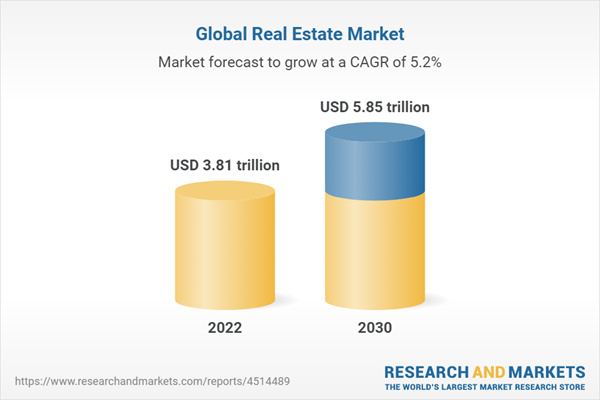The global real estate market size is expected to reach USD 5.85 trillion by 2030, registering a CAGR of 5.2% from 2022 to 2030. Rapid economic expansion in developing countries such as India, China, and several African countries has increased income levels and favored the real estate industry.
Property and condominiums are purchased, sold, rented, and leased in the market for business and personal household usage. Due to an expanded number of significant companies joining the area regional market, the commercial real estate business has risen dramatically in the recent decade. Government reforms, reduced rentals, and lower mortgage rates in developing countries are expected to increase industry growth in the foreseeable future.
Factors, such as the rising demand for housing real estate space and increased urbanization as a result of migration in quest of better amenities are likely to favor the growth of the market. For instance, according to United Nations (UN), approximately 50% of the population lives in urban areas and this figure is set to reach up to 65% in the forecast period owing to the migration into cities that turn into megacities with bustling urban amenities and lifestyle.
In terms of property, the commercial real estate segment is estimated to register a CAGR of 5.1% over the forecast period. The rising popularity of tourism owing to the increasing number of travelers seeking to unwind while enjoying luxury amenities such as hotels are expected to drive the growth of the segment.
The Asia Pacific witnessed dominance in the market with a revenue-based market share of 52.6% in 2021. China accounted for the largest share in the Asia Pacific market and is a hotspot for real estate development and investment supported by a large population. Moreover, various favorable regulations by the governments of various countries in the Asia Pacific including India are likely to favor the growth.
This product will be delivered within 1-3 business days.
Property and condominiums are purchased, sold, rented, and leased in the market for business and personal household usage. Due to an expanded number of significant companies joining the area regional market, the commercial real estate business has risen dramatically in the recent decade. Government reforms, reduced rentals, and lower mortgage rates in developing countries are expected to increase industry growth in the foreseeable future.
Factors, such as the rising demand for housing real estate space and increased urbanization as a result of migration in quest of better amenities are likely to favor the growth of the market. For instance, according to United Nations (UN), approximately 50% of the population lives in urban areas and this figure is set to reach up to 65% in the forecast period owing to the migration into cities that turn into megacities with bustling urban amenities and lifestyle.
In terms of property, the commercial real estate segment is estimated to register a CAGR of 5.1% over the forecast period. The rising popularity of tourism owing to the increasing number of travelers seeking to unwind while enjoying luxury amenities such as hotels are expected to drive the growth of the segment.
The Asia Pacific witnessed dominance in the market with a revenue-based market share of 52.6% in 2021. China accounted for the largest share in the Asia Pacific market and is a hotspot for real estate development and investment supported by a large population. Moreover, various favorable regulations by the governments of various countries in the Asia Pacific including India are likely to favor the growth.
Real Estate Market Report Highlights
- The residential property segment is expected to reach USD 2.21 trillion by 2030, growing at a CAGR of 6.0% from 2022 to 2030. Higher preference for homeownership among millennials is pushing the dominance of the segment in the market.
- The rental type was valued at USD 1.92 trillion in 2021 and is expected to reach USD 3.04 trillion by 2030, owing to the higher spending of the Gen Z generation on rental real estate. Gen Z is the next generation of renters after the millennials and they are predicted to spend more than any other generation on rental services in their lifetime.
- The Middle East region is expected to witness substantial growth over the forecast period with a revenue-based CAGR of 6.3% from 2022 to 2030. The growth is mainly attributed to the rising consumer spending on traveling and investment, Moreover, the rising number of travelers from developing countries, such as India, the Philippines, Vietnam, and Australia, is further estimated to support the growth.
This product will be delivered within 1-3 business days.
Table of Contents
Chapter 1. Methodology and Scope
Chapter 2. Executive Summary
Chapter 3. Real Estate Market Variables, Trends & Scope
Chapter 4. Consumer Behavior Analysis
Chapter 5. Real Estate Market: Property Estimates & Trend Analysis
Chapter 6. Real Estate Market: Type Estimates & Trend Analysis
Chapter 7. Real Estate Market: Regional Estimates & Trend Analysis
Chapter 8. Competitive Analysis
Chapter 9. Company Profiles
Companies Mentioned
- Brookfield Asset Management Inc.
- Atc Ip LLC.
- Prologis, Inc.
- Simon Property Group, L.P.
- Coldwell Banker
- Re/Max, LLC
- Keller Williams Realty, Inc
- Cbre Group, Inc.
- Sotheby’S International Realty Affiliates LLC
- Colliers
Methodology

LOADING...
Table Information
| Report Attribute | Details |
|---|---|
| No. of Pages | 95 |
| Published | April 2022 |
| Forecast Period | 2022 - 2030 |
| Estimated Market Value ( USD | $ 3.81 trillion |
| Forecasted Market Value ( USD | $ 5.85 trillion |
| Compound Annual Growth Rate | 5.2% |
| Regions Covered | Global |
| No. of Companies Mentioned | 10 |









